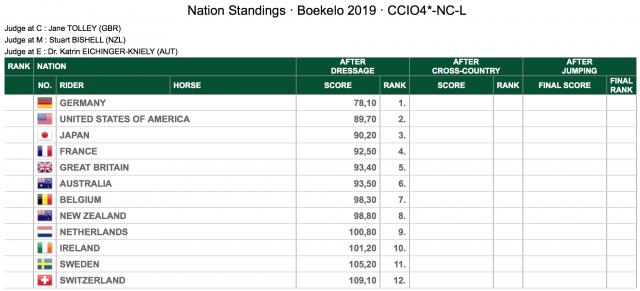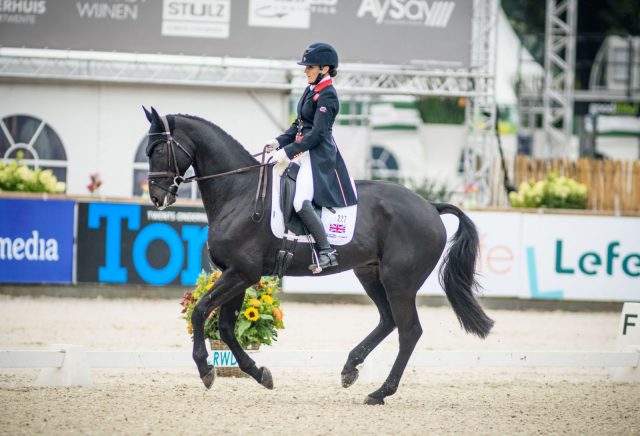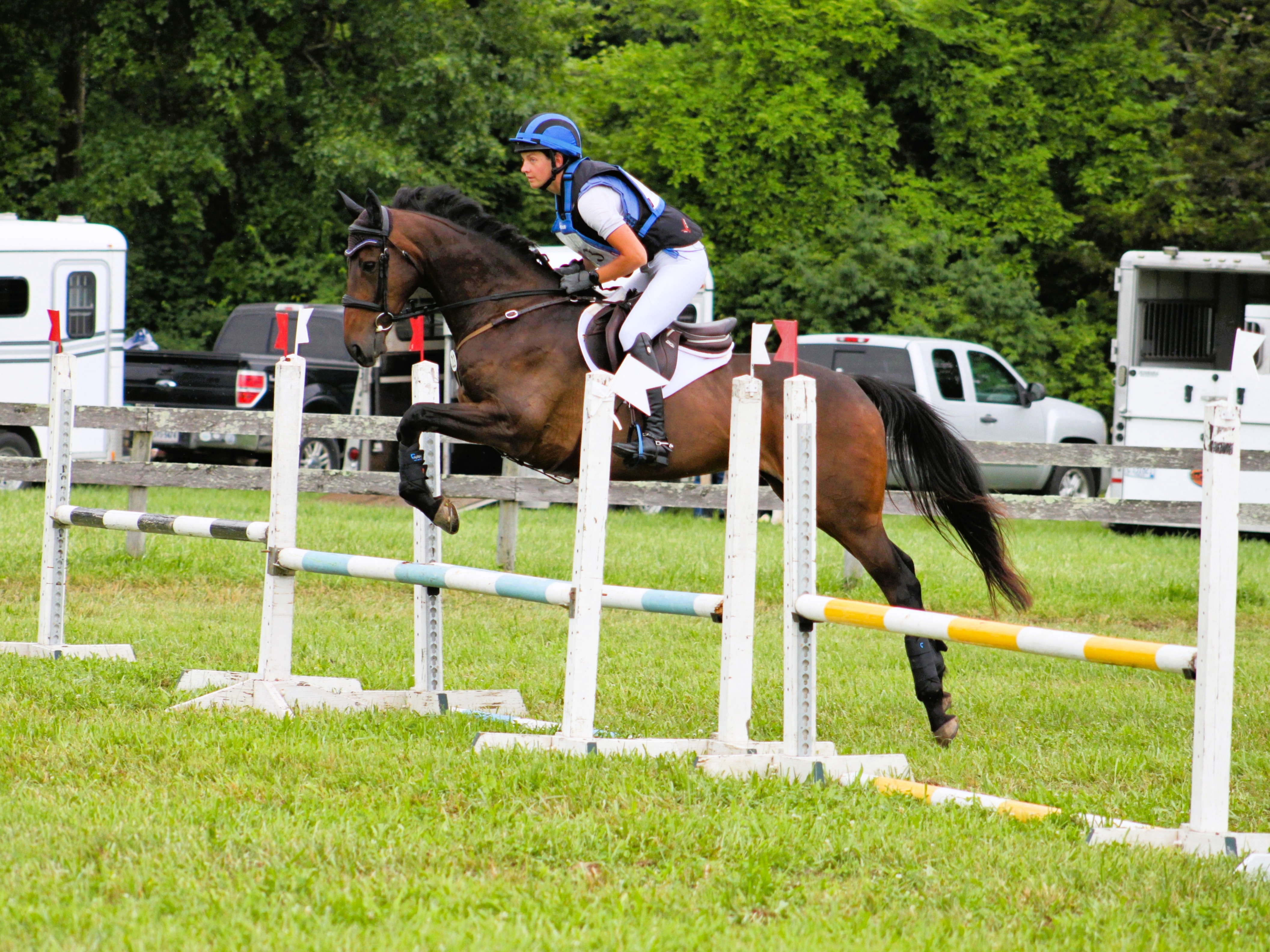
Michael Jung and fischerRocana make their comeback at Boekelo. Photo by William Carey.
And just like that, we’d seen fifty dressage tests.
In a departure from normal form, Boekelo opted to group all its team riders together in the order of go, allowing us to close out the dressage phase conclusively for the Nations Cup today. With twelve teams in it – and three on the hunt for the solitary Tokyo ticket remaining – it was an important day indeed. Let’s take a quick look at the team standings before we delve into the nitty-gritty:
To perhaps no one’s surprise, Germany leads the way heading into Saturday’s cross-country. They boast an aggregate score of 78.1, with all three team members – Sandra Auffarth and Let’s Dance 73, Michael Jung and fischerRocana, and Ingrid Klimke and Asha P sitting in the top ten overnight.

Tamie Smith and Mai Baum deliver the best American result, helping propel the team to second place after dressage. Photo by Tilly Berendt.
Team USA sits just over eleven and a half points behind them in second place, with a combined score of 89.7 totted up by Jennie Brannigan and Stella Artois, Liz Halliday-Sharp and Cooley Quicksilver, and Tamie Smith and Mai Baum.

Kazuma Tomoto and Bernadette Utopia for team Japan. Photo by Tilly Berendt.
The Japanese team, made up of Kazuma Tomoto and Bernadette Utopia, Atsushi Negishi and Ventura de la Chaule JRA, and Yoshi Oiwa and Bart L JRA sit in bronze position on 90.2.

Anna Nilsson and Candy Girl head up the Swedish effort. Photo by Tilly Berendt.
Meanwhile, series leaders Sweden got off to a rocky start after some expensive mistakes earned them a team score of 105.2, which sees them sit in eleventh place out of twelve teams. But on current rankings, they’re still safe – however, they’ll need to try to climb if they want to solidify their hold on the series title. If they don’t, and if Great Britain – currently fifth – were to finish in the top three, they would relinquish the glory.
The Golden Ticket: Who’s on Track for Tokyo?
So what does this mean in terms of the fight for the Tokyo ticket? Well, the competition is far from over, but if it were to end now, here’s what we’d be looking at. Belgium, in 7th place, would add 50 points to their year-long tally, leaving them on 350 points total. The Netherlands are currently in 9th place, which would earn them 40 points – but because the series rankings only use the best six results out of seven competitions, they would discard this and finish on 355. Switzerland, who are currently at the bottom of the leaderboard in 12th place, would also discard the 25 points they would earn today, leaving them on 365. The Swiss would make their merry way to Tokyo – despite not looking good on paper at the moment.
But there’s still so much left to do, and so much that can happen. Both the Dutch and Swiss teams have done themselves an enormous favour by contesting every leg of the series, which – as today’s calculations prove – could end up being incredibly influential.

Constantin van Rijckevorsel and Beat It are the best-placed of the Belgian team, in eighteenth place overnight. Photo by Tilly Berendt.
Let’s look at what has to happen for Belgium, the outliers, to take the ticket. They’ll need to finish in fourth place or better this week, for starters – that’ll put them on a finishing score of 370 or more, which would allow them to beat the current points of their two challengers. Of course, that means that those two teams would both have to use this event as their discard – so for the Netherlands, that would mean a final placing of seventh or worse. For the Swiss, that means finishing in eighth or worse.

Tiziana Realini and Toubleau du Rueire sit best of the Swiss in provisional 23rd place. Photo by Tilly Berendt.
If the Swiss are to take the ticket, things will have to stay as they are in the team rankings – the Netherlands need to finish seventh or worse, while the Belgians would need to finish fifth or worse, which would put them on a maximum possible score of 360.
If the home nation are to take the win, they’ll need to finish fourth or better. A fifth-place finish would put them on 365 points, equal with the Swiss. The Swiss would then need to finish eighth or worse to stay on 365, while the Belgians would need to finish fifth or worse.

Merel Blom and Ceda, twelfth, spearhead the Dutch efforts. Photo by Tilly Berendt.
So what happens in the event of a tie, which is certainly a possibility? If it happens between Belgium and one of the other two teams, it’s simple: the ticket will go to the team that has contested the most legs, which rules Belgium, who missed Pratoni, out. But this won’t work for a tie between the Swiss team and the Dutch team, both of which have competed at every leg. This is where we head swiftly back into calculator territory, I’m afraid.
In this case, a tie-break is decided by referring back to each of the counting legs of the Nations Cup series – that is, the best six out of seven for each team. In this hypothetical situation, in which the Netherlands finish fifth or better and the Swiss finish eighth or worse, here’s how that could work out.
For Switzerland, we’d be looking at Pratoni, Strzegom, Haras du Pin, Waregem, and two further legs: those could be Houghton, where they earned 45 points, Camphire, where they earned 45, or potentially Boekelo where, if they finish in eighth place, they’ll earn 45 points. But let’s save ourselves a headache and say they finish in twelfth, where they currently sit. They’d discard Boekelo, in that case, on just 25 points. Then, the individual rankings of the best three team members at each of those counting competitions would be added together, creating a final aggregate score that includes three riders’ rankings across six events. The team that ends up with a lower score after much scratching of heads and scribbling of sums takes the win. Clear as mud, eh? Let’s all just be glad that someone else has to do those calculations.

The team standings after dressage.
The Movers and Shakers of Day One

Yoshiaki Oiwa and Bart L sit in second place after the first day of dressage. Photo by Tilly Berendt.
Sandra Auffarth and Let’s Dance 73 made great strides for both the German team and their chances of individual victory when they laid down a first-phase score of 24.9, taking the lead overnight. Second place is provisionally held by Japan’s Yoshi Oiwa, who produced an elegant test aboard the former Mathieu Lemoine ride Bart L JRA, with whom he’s developing a formidably competitive partnership ahead of next year’s Olympics.
“I was the third rider for Japan’s team, so I had to be good enough,” says Yoshi, who earned a score of 25.6 for his efforts. “Two seasons now I’ve ridden him, and we understand each other now – he’s a very tall horse, so for me it’s very different. Calle 44 is small and the handling is very good, but this one is very tall with a big canter. But I trust him, and he has enough experience.”

Chris Burton and Clever Louis. Photo by Tilly Berendt.
Australia’s Chris Burton, too, appears to be figuring out a partnership well – but his relationship with Clever Louis is a much shorter one. In fact, this is just their second competition together: their first, the eight- and nine-year-old CCI4*-S at Blenheim last month, saw them take the win after just a month together. Today, they delivered a test that earned them third place and a mark of 26, despite some judging discrepancies that had them variously placed in first, second, and seventh.
“We’re really excited about him – he’s a lovely little horse,” he says. “He wouldn’t be the flashest one out there, but he’s not doing a lot wrong, and that’s what we really like. He’s a strong, tough little eventing horse.”
Clever Louis was produced by Germany’s Ben Leuwer under the tutelage of Dirk Schrade, and Chris has been quick to attribute his rapid trajectory with the horse to his careful production.
“It’s a strange situation, because of course we want to be competitive, but we’re still getting to know one another,” he says. “But with a bit of luck, we’ll know him really well by a certain competition next year that I’d like to have him going well for!”

Michael Jung and Creevagh Cooley. Photo by Tilly Berendt.
Michael Jung offered audiences a special treat as he returned to the main stage with his double Kentucky winner fischerRocana, who makes her comeback after a year out due to injury. She certainly doesn’t appear to have lost any of her charm in that time, either – she sits fourth overnight on a score of 26.1, while stablemate Creevagh Cooley follows close behind in fifth on 26.5. This makes the mare, who Michael bought from a Swedish rider this spring, the only non-team horse to crack the top ten today.
“They were both really nice to ride, though in the beginning a little bit nervous and tense. Here a mistake, there a mistake, a little bit too much to be in the lead. But in the end they both went well and they were nice to ride,” he says of his two tests, which bookended the day’s competition.
While a competitive first phase result is always a reason for celebration, even more special is the feeling of doing so with a long-term partner – but Michael says that it wasn’t always apparent that fischerRocana would return to the top.
“First, I was thinking about breeding with her, not really thinking of the sport. But then we started to train her a little bit and she was always getting better and better,” he explains.

Tamie Smith and Mai Baum. Photo by Tilly Berendt.
Tamie Smith and Mai Baum finished the day as the best of the US team, producing a nearly foot-perfect test to sit sixth overnight on 26.7.
“I had a great time – he was super, and he couldn’t have done any better,” says a beaming Tamie, who has made a habit of putting low-20s scores on the board with the thirteen-year-old gelding. “It’s his best test, but you’ve got to take it the way they give it to you – it’s subjective. But I’m thrilled; I don’t think I could have gotten a better performance out of him. He didn’t have a mistake in the test – it was very clean, and we didn’t leave anything on the table.”
Their efforts helped the US team to second overnight, and Tamie reflects that the international exposure can only be a good thing.
“All you can do is your best – I’m not known, so I have to earn those scores by performing to my best every single time,” she explains. “Eventually, maybe, I’ll see the scores. He’s always been a professional and he’s always given me his all. He can be tricky because he moves so well, which can be difficult to keep contained, but I never felt like he got away from me today.”

Tom Carlile and Birmane. Photo by Tilly Berendt.
A bizarre incident on the way to Boekelo dictated a necessary change to Tom Carlile‘s schedule – “we spent most of yesterday catching up on sleep,” he laughs, explaining that one of his lorry tyres blew on the way through Belgium after it ran over a bit, of all things, on the road. The blowout added six hours to his already twelve-hour journey from central France, and on arrival, Tom’s efforts were entirely focused on making sure his CCI4*-L debutante Birmane was comfortable and settled. As it turned out, it all paid off – the pair scored a 26.9 to sit seventh.
“We were aiming for a 28, so that’s a birdie,” he says with a laugh. “I’m very pleased with her – I’ve had her since the beginning, and we’ve always had a high estimation of her. She has quality, and she has the attitude that comes with quality, but we’ve got a good partnership. She’s really stepping up and performing all the movements quite correctly; she’s only eight and she can be quite distracted by noise, but we did a good job today to get her to concentrate.”
The exciting progression of Birmane helps to dampen the blow of a tough year for Tom, which has seen top horse Upsilon sidelined with a serious neurological condition.
“There’s been plenty of issues – Upsilon was the worst, but it’s been a tough year,” he says. “But we’ve just been trying to keep busy and keep our minds on the positive. There’s no point living in the past; you’ve got to keep walking forward and keep trying to do what you’re aiming for. I do have the impression that I’ve already eaten the dessert of my career with what’s happened with Upsilon, but I do still have a lot of lovely horses.”

Ingrid Klimke and Asha P. Photo by Tilly Berendt.
Ingrid Klimke, too, piloted a young mare to a promising result: SAP Asha P, the winner of last year’s seven-year-old World Championship at Le Lion d’Angers, posted a score of 27.1 in her CCI4*-L debut. Though she’s been a consistent low-20s horse at CCI4*-S, this slightly higher mark won’t rule her out of the game – she’s finished on her dressage score in nearly 50% of her international runs. Though a first long format at this level is always something of a fact-finding mission, it’s unlikely that Ingrid would have brought her to represent Germany if she didn’t feel the fiery mare was ready to play with the big boys. Fans of Ingrid, keep an eye on this one.

Laura Collett and Dacapo. Photo by Tilly Berendt.
Australia’s Kevin McNab sits ninth on a score of 28.5 with Fernhill Tabasco, while Laura Collett rounds out the top ten – and leads the way for the British team – with Dacapo, who put a score of 29 on the board despite a wobble in the second flying change.
“They’re a bit hit-or-miss, because he’s quite a lazy horse. He felt like he was on my aids through the counter-canter, but as I made the turn he just dropped off a bit. The first one was really good for him, though. It was really quite costly, but he was really good,” she says – although, she continues, “there was some horrendous noise going on in one of the marquees, and he was sort of flicking an ear on it. Luckily, it didn’t really affect him – I was just lucky I was on him and not something a bit sharper.”

Jennie Brannigan and Stella Artois. Photo by Tilly Berendt.
Jennie Brannigan acts as US team pathfinder this week, and she’ll head out of the box on a mark of 31.3. This puts her and the striking eleven-year-old Stella Artois in equal nineteenth place with Padraig McCarthy and Leonidas and Astier Nicolas and Babylon de Gamma, although she, too, suffered a drastic judging discrepancy: while two of the judges had her on 70% and in 14th place, the third awarded her just 66.04%, which would have put her into 31st.
“I was a bit bummed, obviously, that the one judge had me so much lower, but I was talking to Erik [Duvander] yesterday, and we were saying it’s more about thinking about how exciting the future can be,” explains Jennie, who has been training with James Burtwell on the flat for the past two months. “It’s really exciting to have proper help, because I’ve been doing it a lot on my own. Having the right people helps so much. Everyone’s always said ‘oh, the mare’s so strong, you have to dominate her’ – but I just thought, ‘no, she’s got to breathe, too – there has to be a way to be kind to her without being too soft and letting her do what she wants.’ You can’t just muscle her around – she’s a mare, and she’s sensitive, and I think James has really helped me find that balance. The improvement we’ve made with Erik, too, in the past week has been awesome.”
To have Stella Artois at Boekelo is particularly special for Jennie – she found her while competing at Luhmühlen, and this week, she’s surrounded by the mare’s connections made throughout the process. Now, she’s delighted and excited to act as pathfinder for the US team – and she’s gained an innate confidence in herself, too, that allows her to get the best out of the mare, even when she has her trickier moments.
“She’s such a lovely horse, and at the end of the day, she’s really fit and loves the rest of the phases as well,” she explains. “She felt great in the warm-up, but when I went to go in she actually got a little bit sharp. This is probably her first event that has this much atmosphere. But what I’m happy about is that I feel comfortable in the ring now, and I can keep a lid on it and get her relaxed. For a long time, I was taken on trips when I was really young and didn’t feel quite ready for the atmosphere, but now I feel very comfortable. You always want it perfect, but I’m happy it’s going the right way.”

Liz Halliday-Sharp and Cooley Quicksilver. Photo by Tilly Berendt.
He might be referred to as ‘the noodle’ at home, but Liz Halliday-Sharp‘s Cooley Quicksilver certainly looks to be learning how to use his various appendages to their best advantage. Some green moments precluded a sub-30 finish, but they weren’t far off – the pair sit 23rd overnight on a score of 31.7.
“He’s only an eight-year-old, and he’s quite a puppy, still, in himself,” she says with a laugh. “He’s a very young horse to sit on still in that way. In some ways, he’s quite grown-up, though, from having been to Le Lion twice. We’re trying new warm-up techniques, and today we did a lot less than usual – when he was younger, he’d often do something off-piste in the arena, like launch into the air or do something stupid. I think it was the right way forward, because we got a lot more pizazz in the work.”
The greenness showed through in the changes, which Liz attributes to weakness rather than any lack of try.
“He does beautiful changes in the warm-up, but he got a bit behind me, so that was a real shame,” she says. “But there was a lot of good there, and he’ll have learned a lot from it. This horse is going to do the most spectacular test when he’s ten – he’s the wiggliest, most flexible horse I’ve ever sat on, and that can be hard for them when they’re not established. It’s just body parts moving in forty different directions!”
We’ll be back tomorrow with a jam-packed day of individual dressage tests – keep it locked onto EN for the full report. Until then – Go Eventing!

The individual top ten after the first day of dressage at Boekelo.
Military Boekelo: Website, Entries, Ride Times, Live Stream, Live Scores, EN’s Coverage, EN’s Twitter, EN’s Instagram



















